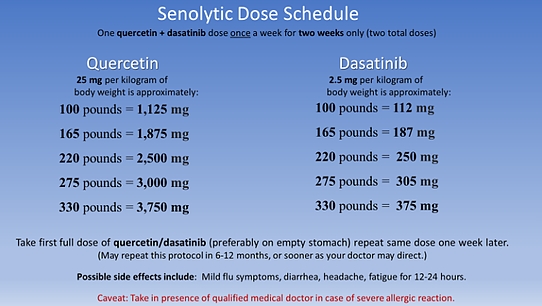
Step 3: Eliminate senescent cells from your body
As cells reach the end of their life cycle or become severely damaged, most self-destruct via a normal process known as apoptosis.
Some cells fail to undergo this beneficial self-elimination process and instead linger in a dysfunctional “zombie-like” state where they impede organ function, emit damaging inflammatory signals, and thus shorten healthy lifespan.
These “senescent cells” often spread throughout tissues like a contagion and inflict massive damage, which can result in organ failure and degenerative disorders related to persistent low-grade inflammation.
Senescent cells survive by evading apoptotic mechanisms the body normally uses to eliminate them.
Recently published studies reveal that just a few senescent cells transplanted into young mice result in persistent physical decline characteristic of pathological aging.
When senescent cell–laden mice that are the human equivalent of 75-90 years old were given compounds (senolytics) that selectively eliminated senescent cells, there was an alleviation of physical decline. The old mice treated with senolytic compounds lived a remarkable 36% longer.
As it relates to the goal of systemic age reversal by means of a sequential order of regenerative therapies, a logical first intervention is to purge your body of these “toxic” senescent cells.
Senolytic therapy has not only demonstrated profound rejuvenating properties by itself, but may open up opportunities for other rejuvenation strategies to be more effective.
For instance, if you are considering infusions of mesenchymal stem cells, young plasma, or umbilical cord-derived cells/plasma, you want your body to be in a metabolic state that welcomes these pro-youth interventions.
If your body is in a condition of chronic inflammation, with cell-to-cell communication severely compromised, it’s hard to imagine these young plasma therapies having profound or long-lasting benefits. Senescent cells generate a firestorm of destructive inflammatory factors that may result in otherwise powerful therapies being wasted on the task of cleaning up the mess of damaging signaling factors, such factors that could easily have been removed ahead of time using senolytic compounds.
As you’ll learn this weekend, senolytic therapy by itself is demonstrating impressive regenerative effects. So much so that most self-experimental study subjects are seeking to repeat this intervention after 6 months.
The senolytic cocktail that some of our supporters have been experimenting with is a combination of dasatinib, a well-studied cancer drug, and high-dose quercetin, a phytochemical found in some of the foods we eat daily.
This treatment should be done under the supervision of a healthcare provider, although we have not yet heard of any serious side-effects or adverse events from this protocol. Dasatinib and quercetin have demonstrated potent senolytic and subsequent age-reversal properties when used together in appropriate doses.
The following two slides are current dosage schedules and pricing alternatives based on what we know at the time of publishing this article (September 2018):

